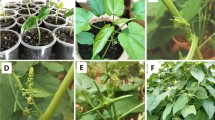Summary
Field experiments were conducted to evaluate and compare the yield and agronomic characteristics of anther-culture-derived (AC) lines in rice and the parents under saline and nonsaline soil conditions. The yield stability of two entries was also evaluated by comparing their performance under two distinct nonsaline soil environments. The test entries were planted in randomized complete block design with four replications at each test location. Data were collected on grain yield, yield components, and agronomic characteristics. This study demonstrates that through anther culture, it is possible to produce homozygous diploid lines in a short time. The possibility of regenerating recombinants with desirable characteristics such as good plant type and salinity tolerance, higher yield, and increased resistance to pests and diseases from both the parents is high.
Similar content being viewed by others
References
Akbar M, Ponnamperuma FN (1982) Saline soils of South and Southeast Asia as potential rice lands. In: Rice strategies for the future. IRRI, Los Banos, The Philippines, pp 265–281
Akita S, Cabuslay GS (1988) Physiological basis of differential response to salinity in rice cultivars. In: Proc 3rd Int Symp Genet Aspects Plant Miner Nutr, 19–24 June, 1988, Braunschweig, Germany, 37 pp
Flowers TJ, Troke PF, Yeo AR (1977) The mechanism of salt tolerance in halophytes. Annu Rev Plant Physiol 28: 89–121
International Rice Research Institute (1988) Standard evaluation system for rice. The International Rice Testing Program, Manila, The Philippines, 54 pp
Ogura H, Kyozuka J, Hayashi Y, Koba T, Shimamoto K (1987) Field performance and cytology of protoplast-derived rice (Oryza sativa): high yield and low degree of variation of four japonica cultivars. Theor Appl Genet 74: 670–676
Oono K (1983) Genetic variability in rice plants regenerated from cell culture. In: Cell and tissue culture techniques for cereal crop improvement. Science Press, Beijing, pp 95–106
Oono K, Sakaguchi S (1978) Induction of mutation in tissue culture and their use for plant breeding. II. Induction of saline resistant and copper sulfate resistant calluses and regeneration of plants. Jpn J Breed 28 [Suppl.2]: 124–125 (in Japanese)
Oono K, Sakaguchi S (1980) Mutations induced by rice tissue culture. IV. Induction of saline resistant mutants. In: Proc 7th Symp Plant Tiss Cell Cult, Tsukuba, Japan, p 7 (in Japanese)
Schaeffer GW, Sharpe FT Jr, Cregan PB (1984) Variation for improved protein and yield from rice anther culture. Theor Appl Genet 67: 383–389
Senadhira D (1987) Salinity as a concept to increasing rice production in Asia. In: Proc Regional Workshop on Maintenance of Life Support Species in Asia-Pacific Regions, 4–7 April, 1987. NBPGR, New Delhi, India
Subhashini K, Reddy GM (1989) In vitro selection for salinity and regeneration of plants in rice. Curr Sci 58: 584–586
Sun Z, Zhao C, Zheng K, Qi X, Fu Y (1983) Somaclonal genetics of rice, Oryza sativa L. Theor Appl Genet 67: 67–73
Vajrabhaya M, Thanapaisal T, Vajrabhaya T (1989) Development of salt-tolerant lines of KDML and LPT rice cultivars through tissue culture. Plant Cell Rep 8: 411–414
Ye JM, Kao KN, Harvey BL, Rossnagel BG (1987) Screening salt-tolerant barley genotypes via F1 anther culture in salt stress media. Theor Appl Genet 74:426–429
Yeo AR, Yeo ME, Flowers SA, Flowers TJ (1990) Screening of rice (Oryza sativa L.) genotypes for physiological characters contributing to salinity resistance, and their relationship to overall performance. Theor Appl Genet 79: 377–384
Yoshida S (1981) Fundamentals in rice crop science. The International Rice Research Institute, Los Banos, Laguna, The Philippines, 269 pp
Zapata FJ (1985) Rice anther culture at IRRI. In: Burn K (ed) Biotechnol Int Agric Res. Proc Inter-Center Semin IARCs Biotechnol, 23–27 April 1984. IRRI, Los Banos, The Philippines, pp 85–95
Zapata FJ, Abrigo EM (1986) Plant regeneration and screening from long-term NaCl-stressed rice callus. Int Rice Res Newslett 11:24–25
Zapata FJ, Ella ES (1988) Specific gravity of the grain — a factor to consider in rice somatic cell culture. J Plant Physiol 132:294–297
Author information
Authors and Affiliations
Additional information
Communicated by G. Wenzel
Rights and permissions
About this article
Cite this article
Zapata, F.J., Alejar, M.S., Torrizo, L.B. et al. Field performance of anther-culture-derived lines from F1 crosses of Indica rices under saline and nonsaline conditions. Theoret. Appl. Genetics 83, 6–11 (1991). https://doi.org/10.1007/BF00229219
Received:
Accepted:
Issue Date:
DOI: https://doi.org/10.1007/BF00229219




